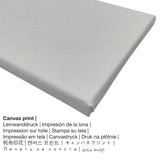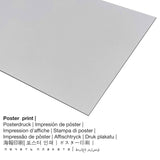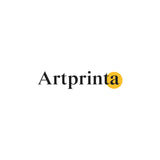Peter Paul Rubens, 1606 - Marchesa Brigida Spinola Doria - fine art print
Tax included. Shipping calculated at checkout.
General description from National Gallery of Art (© - by National Gallery of Art - www.nga.gov)
Medium: Oil on canvas
Dimensions: Canvas: 152.5 x 99 cm (60 1/16 x 39 in.) Framed: 188 x 134.6 x 10.8 cm (74 x 53 x 4 1/4 in.)
Peter Paul Rubens lived and studied in Italy between 1600 and 1609, absorbing the country's cultural riches and artistic heritage. During a stay in Genoa in 1606, he painted the portrait of Marchesa Brigida Spinola Doria. The 22-year-old newlywed was from one of the republic's leading noble families. The imposing setting and the marchesa's aristocratic appearance leave little doubt that she was a person of wealth and status. Rubens integrated light and color, as well as the marchesa's pose and the dynamic diagonals of the architecture, to enliven her stately image. Light flooding into the scene creates boldly expressive folds in her heavy satin dress, while the red of the drape adds dramatic emphasis. The direction of her gaze and the perspective of the architecture indicate that the painting was meant to be hung high on a wall—well above the viewer.
A drawing in the Morgan Library & Museum in New York City reveals that the picture was originally even grander: Rubens executed a full-length portrait, with the marchesa standing on a terrace with a view into the distant landscape at the left, but unfortunately, at some point during the 19th century, the canvas was cut down to its present format.
The marchesa's young face, animated by her large, keen brown eyes and gentle smile, is set off by her enormous yet elegant ruff. Her commanding presence is further accentuated by the glowing satin, the lace of her gown, her jewels, and the elaborate hair ornament crowning her carefully curled locks. Behind her, the rich luster of the marble and stone of a palazzo add to the sense of limitless luxury. The Spinola family, major art patrons in Genoa, derived their affluence from mercantile and banking enterprises. It was the norm for families to consolidate their wealth through intermarriage, and Brigida Spinola married her cousin Giacomo Massimiliano Doria in 1605. Widowed in 1613, she later married the widower Giovanni Vincenzo Imperiale, a senator of the Genoese republic who was also devoted to poetry and art collecting. The marchesa's self-possession also may have been engendered by the unusual—for that era—legal rights and civic role that Genoa's constitution granted its women. The future Pope Pius II, while still a youthful secretary to a Cardinal, commented that Genoa was a "paradise for women."
Rubens visited Genoa, a wealthy financial and mercantile center, at least twice and clearly admired the city and its people. Their active lifestyles as bankers, merchants, ship owners, and military leaders would have reminded him of Antwerp, the economic and cultural center of the Southern Netherlands. By the time he made this portrait, Rubens had been in Italy six years. Trained in classical ideals and philosophy, he had travelled from Antwerp to Italy around 1600 to experience firsthand its artistic traditions, not only those coming from antiquity and the Renaissance, including the work of Raphael and Michelangelo, but also those being created by contemporary artists such as Caravaggio. The inspiration he gained from this multifaceted exposure profoundly affected his own style of painting and became the foundation for his future work.
Structured artwork data
| Painting name: | "Marchesa Brigida Spinola Doria" |
| Classification of the artwork: | painting |
| Broad category: | classic art |
| Artwork century: | 17th century |
| Artpiece year: | 1606 |
| Artwork age: | around 410 years |
| Painted on: | oil on canvas |
| Original artwork size: | 152,5 x 99 cm (60 1/16 x 39 in) |
| Museum / collection: | National Gallery of Art |
| Location of museum: | Washington D.C., United States of America |
| Museum website: | National Gallery of Art |
| License type: | public domain |
| Courtesy of: | National Gallery of Art, Washington |
Artist details table
| Name: | Peter Paul Rubens |
| Aliases: | Rubens Pierre-Paul, Rubens d'Anversa, P. Paulus Rubbens, Rubens ou sa manière, Rubens Pietro Paolo, Rubenso fiamengo, Petro Paulo Rubes, Ruben, P. Pauel Rubens, Pieter Paul Rubbens, Peter Paul Rubens, Pietro Paolo Fumino, Pieter Paulo Rubbens, P. Paolo Rubens, P.-P. Rubens, Rubens P.P., Pietro Pauolo Rubens, Pablo Rubes, Sir P. Paul Rubens, Rubens P. P., רובנס פטר פול, Petrus Paulus Rubbens, P. v. Rubens, P. P. Rubens, Pet. Paul Rubens, Rubenns Peter Paul, Rupens, Pedro Pablo de Rubenes, Pietro Paolo Rubbens, Petro Paul Rubens, Pierre-Paul Rubens, Chev. Pet. Paul. Rubens, Sir P. P. Rubens, Ruwens, Reubens, Rubens Pieter-Pauwel, Pierre Paul Rubbens, Sir P.P. Rubens, Pieree Paul Rubens, Pedro Pablo Rubenes, רובנס פטר פאול, Rubens Sir, Ruebens Peter Paul, Rubens Pieter Paul, Paul Reubens, Pierre Rubens, Rubins, P. Rubbens, Pietro Paolo Rubens, Peter Paolo Rubens, Petri Paulo Rubbens, Rubbens, P.P Rubens, Pietro Pauolo, rrubes, Paulo Rubbens, Rubens Sir Peter Paul, petrus paul rubens, Pietro Paulo Rubens, Petro Paulo Rubbens, rubens p. p., pieter paul rubens, Reuben, P.P. Rubbens, Pietro Paolo, Piere Paul Rubens, Paul Rubens, Sir P.Paul Rubens, P. Reuben, P. Paulo Rubbens, P.P. Rubeens, Rubens ou dans sa maniere, Rubens Peeter Pauwel, P.o Pablo Rubens, Rhubens, Sir Peter Paul Rubens, P. Paul Rubens, Rubenns, P: P: Rubbens, Ribbens, Rubens, Pierre-Paul Rubbens, Ubens Fiammingo, Buddens, Rubens Pietro Paolo, Rubens Peter Paul, Ruben Peter Paul, Rubens Sir Peter Paul Flem., Rurens, Ruuenes Peter Paul, Pieter Paulus Rubbens, Paolo Rubens, Rubeen, Rubben, Rubin, Peter Paul Reubens, Sir P. Reuben, Petrus Paulus Rubens, Ruebens, Rubenes, Pierre Paul Rubens, Pietropaolo Rubenz, Ruvens, Pietro Robino, Rubens Peter Paul, Peter Poulo Ribbens, Ruben's, Ruvenes, rubens petrus paulus, P. Ribbens, P. Rubens, Bubens, P. P. Reubens, Pedro Paulo Rubbens, P.P. Rubens, Rubens Peter Paul Sir, P. P. Rubbens, PP. Rubens |
| Gender of the artist: | male |
| Nationality of artist: | Dutch |
| Jobs of the artist: | diplomat, painter |
| Country of origin: | the Netherlands |
| Classification of the artist: | old master |
| Styles: | Baroque |
| Life span: | 63 years |
| Born: | 1577 |
| Place of birth: | Siegen, North Rhine-Westphalia, Germany |
| Died in the year: | 1640 |
| Deceased in (place): | Antwerp, Antwerpen province, Flanders, Belgium |
Structured article information
| Print product type: | art print |
| Reproduction: | reproduction in digital format |
| Manufacturing process: | UV direct print (digital printing) |
| Production: | manufactured in Germany |
| Type of stock: | production on demand |
| Intended product usage: | wall picture, art print gallery |
| Orientation of the image: | portrait format |
| Image aspect ratio: | 2 : 3 - length : width |
| Meaning: | the length is 33% shorter than the width |
| Material variants: | acrylic glass print (with real glass coating), metal print (aluminium dibond), canvas print, poster print (canvas paper) |
| Canvas on stretcher frame (canvas print) variants: | 20x30cm - 8x12", 40x60cm - 16x24", 60x90cm - 24x35", 80x120cm - 31x47", 100x150cm - 39x59" |
| Acrylic glass print (with real glass coating) sizes: | 20x30cm - 8x12", 40x60cm - 16x24", 60x90cm - 24x35", 80x120cm - 31x47", 100x150cm - 39x59" |
| Poster print (canvas paper): | 40x60cm - 16x24", 60x90cm - 24x35", 80x120cm - 31x47" |
| Aluminium dibond print options: | 20x30cm - 8x12", 40x60cm - 16x24", 60x90cm - 24x35", 80x120cm - 31x47" |
| Frame: | please note that this art copy has no frame |
Get your preferred art print material
For every fine art print we offer a range of different materials and sizes. The following sizes and materials are the options we offer you for individualization:
- Acrylic glass print (with real glass coating): An print on acrylic glass, which is often named as a fine art print on plexiglass, will change an original work of art into amazing décor. The work of art will be custom-made with state-of-the-art UV direct printing technology.
- The poster print (canvas material): The poster print is a UV printed flat canvas with a slight finish on the surface, that reminds the original masterpiece. Please bear in mind, that depending on the absolute size of the poster we add a white margin of approximately 2-6cm around the painting, which facilitates the framing.
- Canvas: A canvas direct print is a printed cotton canvas stretched on a wood stretcher. A printed canvas of your favorite masterpiece will allow you to transform your own into a large size collection piece. Hanging your canvas print: Canvas prints are relatively low in weight, meaning that it is easy and straightforward to hang the Canvas print without the help of extra wall-mounts. Canvas prints are suitable for any kind of wall.
- Aluminium dibond: These are metal prints on aluminium dibond with an impressive effect of depth, which creates a modern impression by having a surface structure, which is not reflective. The Aluminium Dibond Print is the best introduction to the sophisticated world of art prints made with aluminum. For our Direct Print On Aluminum Dibond, we print the favorite artwork right onto the surface of the aluminum material.
Art product summary
In 1606 the male Dutch artist Peter Paul Rubens created the classic art piece of art. The original version measures the size: 152,5 x 99 cm (60 1/16 x 39 in). Oil on canvas was applied by the European painter as the medium of the painting. Moveover, this artwork belongs to the National Gallery of Art's art collection in Washington D.C., United States of America. The classic art public domain masterpiece is provided with courtesy of National Gallery of Art, Washington.: . The alignment is portrait with a side ratio of 2 : 3, meaning that the length is 33% shorter than the width. The diplomat, painter Peter Paul Rubens was an artist, whose style can be attributed mainly to Baroque. The Dutch artist lived for a total of 63 years and was born in the year 1577 in Siegen, North Rhine-Westphalia, Germany and deceased in the year 1640 in Antwerp, Antwerpen province, Flanders, Belgium.
Legal note: We try to describe our products as accurate as possible and to exhibit them visually. Still, the tone of the printing material and the printing may differ to a certain extent from the image on the screen. Depending on your screen settings and the nature of the surface, color pigments can unfortunately not be printed as exactly as the digital version. Bearing in mind that our art prints are printed and processed by hand, there may also be minor variations in the motif's size and exact position.
© Copyright of, Artprinta.com (Artprinta)














